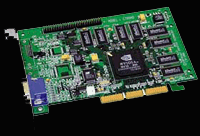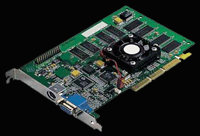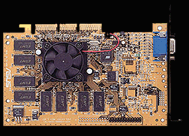GeForce
256 Roundup
Difficult
to get, too hot to handle.
Here is a roundup of the best GeForce 256s in the market today.
Creative Labs 3D Blaster Annihilator
 The
Annihilator is a bare-bones GeForce card. There's no TV-out and no game bundle.
But Creative makes up for that with some terrific display utilities, including
a system tray icon that lets you change resolutions and color depths on the
fly. As with all the GeForce cards we've tested, the Annihilator's image quality
and game compatibility are excellent. 3D scenes are rendered sharply, the
colors are bright and accurate. There were no incompatibilities under Direct3D
or OpenGL in the games we've tested. The Annihilator has your standard 32mb
SDRAM, 120-MHz core clock speed, 166-MHz memory clock and an AGP 2X/4X interface
. Performance was in-line with the other GeForce cards. Quake III Arena, everyone's
favorite shooter, ran at 47 frames per second at 1,024 by 768 and 32-bit colors.
The
Annihilator is a bare-bones GeForce card. There's no TV-out and no game bundle.
But Creative makes up for that with some terrific display utilities, including
a system tray icon that lets you change resolutions and color depths on the
fly. As with all the GeForce cards we've tested, the Annihilator's image quality
and game compatibility are excellent. 3D scenes are rendered sharply, the
colors are bright and accurate. There were no incompatibilities under Direct3D
or OpenGL in the games we've tested. The Annihilator has your standard 32mb
SDRAM, 120-MHz core clock speed, 166-MHz memory clock and an AGP 2X/4X interface
. Performance was in-line with the other GeForce cards. Quake III Arena, everyone's
favorite shooter, ran at 47 frames per second at 1,024 by 768 and 32-bit colors.
Guillemot Prophet 3D
 Higher
up the GeForce ladder is the 3D Prophet. It's a fairly straight forward card
that implements the Nvidia reference design, reference display drivers and
utilities. The Prophet edges out the 3D Blaster Annihilator in features. Guillemot's
GeForce card has an S-Video Out jack and a converter cable to offer composite
output. Powered by the Brooktree 869 video encoder chip, the Prophet supports
640-by-480 and 800-by-600 resolutions. TV-out quality in games is actually
quite good; you can play your favorite games on a large-screen TV at 640 by
480 and still get accurate colors. The only problem with the TV-out electronics
is that it does a poor job with text, which is very fuzzy. Also, there are
no controls for sizing and positioning the TV display.
Higher
up the GeForce ladder is the 3D Prophet. It's a fairly straight forward card
that implements the Nvidia reference design, reference display drivers and
utilities. The Prophet edges out the 3D Blaster Annihilator in features. Guillemot's
GeForce card has an S-Video Out jack and a converter cable to offer composite
output. Powered by the Brooktree 869 video encoder chip, the Prophet supports
640-by-480 and 800-by-600 resolutions. TV-out quality in games is actually
quite good; you can play your favorite games on a large-screen TV at 640 by
480 and still get accurate colors. The only problem with the TV-out electronics
is that it does a poor job with text, which is very fuzzy. Also, there are
no controls for sizing and positioning the TV display.
The card performes well, on the level of other GeForce cards in this roundup.
Because all the cards are clocked at the same speed, 120-MHz core clock speed
and 166-MHz memory clock, and all are using 32mb of SDRAM, their performance
are similar.
Guillemot is a brand that is not readily available from computer shops in
the Metro. Heck, few stores stock up on GeForce 256 cards because it's an
expensive piece of hardware. But most stores will gladly order one for you.
For buyers looking for a good, mid-priced GeForce with good utilities and
TV-out capability, the Guillemot 3D Prophet fits the bill perfectly.
Asus AGP V-6600
The new Asus V-6600 has a TV-in as well as a TV-out port, just like the TNT2-based
3800. These rare features make both cards very appealing to many buyers.
 The
V-6600 uses Nvidia's GeForce 256 chipset. Using 3.48 drivers, the card performs
at par with other GeForce. There's 32MB of the 200MHz, 5 nanosecond SDRAM
memory, S-video, composite video inputs and outputs and a jack at the back
of the card for 3D glasses. A lot of improvements were made on the card TV
in/out electronics compared to the older 3800, whose video-capture circuits
would bog down at anything over 15fps. The V-6600 can now handle a constant
30 frames-per-second at resolutions of 320x240.
The
V-6600 uses Nvidia's GeForce 256 chipset. Using 3.48 drivers, the card performs
at par with other GeForce. There's 32MB of the 200MHz, 5 nanosecond SDRAM
memory, S-video, composite video inputs and outputs and a jack at the back
of the card for 3D glasses. A lot of improvements were made on the card TV
in/out electronics compared to the older 3800, whose video-capture circuits
would bog down at anything over 15fps. The V-6600 can now handle a constant
30 frames-per-second at resolutions of 320x240.
Asus ships great software with the card. It lets you check whether the onboard
fan is turning, how fast it's turning, the temperature of the GeForce 256
chip, and its voltage draw. Toss in Asus' clock-rate-tweaking software, and
you have a good set of tools for tweaking the card's clock rate and all kinds
of fiddling. And; in case you make a mistake, there's a safe-mode recovery
utility that resets the card to its factory defaults. The core clock can be
cranked all the way up to 142MHz and the memory to 195MHz. We were able to
crank it up to 130/195 for five hours of gaming without hiccups. Of course,
results may vary on other systems, but in general, you can expect a card to
run at 120/166.
Summing it up
All cards still fall short of the Holy Grail of 60 frames per second when
run at max settings (1024x768,32-bitcolors). But as the newer games start
to take advantage of the GeForce's hardware transform and lighting engine,
we think frame rates will improve a bit as the CPU is spared from the tiresome
task of rendering lighting in software mode.
In our tests, all cards performed on the almost the same level. Overclockers
will be somewhat disappointed with the GeForce 256 as there doesn't seem to
be a huge impact on actual game performance by cranking up the clock rates.
The chips on these cards are surprisingly stable for a brand-new architecture
while performing like a next-generation card should, delivering faster and
higher quality graphics than anything you've seen before.
The Asus AGP V-6600 earns our nod of approval as the best among the three
GeForce 256 cards we've tested so far. Users wanting TV-out, good video capture
capability, and a terrific software bundle including an excellent thermal
health-monitoring software, get more bang for the buck with this card. The
faster 200MHz memory clock raises the cost a bit more than the others, but
you get your money's worth.
The Creative Labs 3D Blaster Annihilator, on the other hand is a no-frills
card with terrific software thrown in. Do not look for TV-out and stuff because
all you get is your basic VGA port. The low cost of the Annihilator makes
it very tempting for the budget-conscious player. ![]()
by M.B.Reyes
![]()
Related Articles:
Guillemot 3D Prophet
Guillemot 3D Prophet II GTS